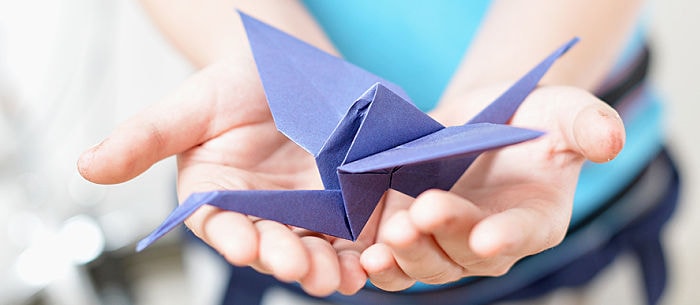Are you ready to try origami for kids? By introducing challenging new activities like origami (the art of folding paper into decorative shapes and figures), parents and caregivers can help kids develop new skills. “Origami is excellent for developing fine motor skills, spatial intelligence, stress control and math,” says Japanese origami expert Gerardo Gacharná Ramírez of Neorigami, adding, “Yet, I think kids should try it simply because it’s enjoyable.
Origami is a whole new and welcoming world. “But it does require some practice,” Yuki Martin, creator of Yuki’s Origami Blog, says. “When I teach young children who haven’t had any experience in origami, I often choose a very simple model that is also fun to play with afterward, such as a finger puppet, a jumping frog or a spinning top. It is very rewarding to be able to play with it after folding it.”
Plus, it’s a great way to introduce kids to a different culture — in this case, to Japan, where origami originated. Monks first brought paper to Japan from China in the sixth century, according to PBS. At first origami was strictly for ceremonial purposes, but later it became recreational, with the first origami instructions being printed in 1797.
How to Make Origami Easier for Kids
For a rewarding and successful origami experience, follow these tips:
- Start with plain — and cheap– paper, so you don’t get frustrated when your child rips the more expensive stuff.
- Find simple projects that capture your child’s interest — for example, a beginner dog for your pet lover.
- Take breaks. Most origami projects take an hour or more to finish.
- Explain fractions so your child has a basic understanding of things like “half” and “fourth.”
- Read the instructions yourself first and be prepared with the correct paper size before introducing the project to your child.
- Help pre-crease the paper for younger children to make it easier for them make the folds.
10 Fun Origami Projects for Kids
These designs are good for children to try:
- Origami Dolls
Make a familiar item. Fold and color origami dolls, with these instructions from Enchanted Learning.
- Origami Cup
Your child will love creating something useful — folding and even drinking out of this origami cup from Activity Village.
- Basic Fish
Master the basic fish, as illustrated on Kidspot, which uses one of the most basic folds — the mountain fold. Conquering this fold opens up the doors to a wide range of projects.
- Jumping Frogs
Turn an origami project into a game! Kids love seeing which frog can jump farthest after making these jumping frogs from Creative Jewish Mom.
- Origami Hat
This project from Origami-Fun is a great birthday party activity. Provide plenty of stickers and crayons so kids can create wearable fashion incorporating their own unique style.
These projects are more challenging:
- Bunny Rabbit
The bunny rabbit from Origami-Make is an easier, 10-fold version of the traditional bunny rabbit design, which has 26 folds. Master the simplified version and work your way up to the traditional.
- Cootie Catcher
Do you remember the cootie catcher (a.k.a. fortune teller) from your grade-school days? This craft from Enchanted Learning will bring back memories as you teach your child how to work it out.
- Origami Cubes
These colorful cubes from Origami Mommy go together like a puzzle. Use a variety of bold shades of paper to make the cubes pop.
- Heart Rings
Jewelry like these rings from All About Origami is fun for kids to make — and wear! Create extra to share and trade with friends.
- The Origami Yoda
Crafting Yoda, as instructed by Origami Yoda, is more challenging than the other projects, but Star Wars fans will be eager to rise to the challenge perhaps with some parental help. Also, the author of this one offers easier versions if this one proves too challenging.
“Origami for kids is full of developmental benefits,” says Martin. “It helps kids learn about geometry and math, build fine motor skills and sequencing skills, develop creative and intellectual abilities and much more — not to mention it is a fun activity that requires only a piece of paper.” Try it today!
Rachael Moshman, who has her master’s degree in education, loves watching her daughter explore origami. She once made origami flowers for each place setting at the dinner table.






